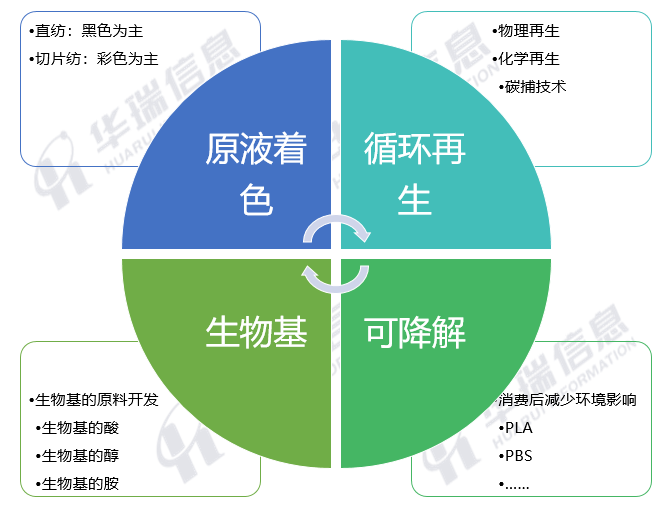Product Consultation
Your email address will not be published. Required fields are marked *
Recently, the author once again visited the yarnexpo autumn and winter yarn exhibition and the Intertextile textile fabrics and accessories exhibition held at the Shanghai National Convention and Exhibition Center. The theme of the autumn and winter yarn exhibition is the same as that of the spring and summer exhibition in March. Fibers under the fusion and all-encompassing themes still focus on diversity, nature, function and upgrade. In terms of chemical fiber, the functionality and low-carbon, environmentally friendly and green development of fiber are still outstanding. This is also a variety that downstream brands like to see and use.
This time I will not go into specific factories, but mainly want to talk about the green development of chemical fiber. From the perspective of the development of green fiber, it can be summarized into four major paths:

1. Liquid coloring mainly reduces the dyeing of gray fabrics and achieves environmental protection.
This is a relatively early and mature topic in polyester filament. There are already many mature direct spinning and chip spinning factories. Among them, direct spinning mainly produces relatively large amounts of black silk, while chip spinning In terms of production, most of them produce colored silk, and the production of colored silk is also carried out simultaneously in two modes: order-based and supermarket-based.
In recent years, the development of chemical fiber colored yarn has extended to polyester staple fiber, nylon yarn, polyamide 6 fiber, polypropylene fiber and so on.
2. Recycling, mainly the recycling and reuse of post-consumer finished products, forming a closed loop of resources.
The variety of recycled chemical fibers is also increasing, with polyester, nylon, and polypropylene being the main ones. Spandex, acrylic, and lyocell recycled fibers have also been supplied to the market. Taking mature polyester filament recycling as an example, regeneration is developed from the production method and mainly includes two aspects: physical regeneration and chemical regeneration. The physical method does not destroy the original molecular structure, but the chemical method destroys the reorganization of the molecular structure. Relatively speaking, the chemical method has higher purity and cost, and is more difficult.
There are not many chemical regeneration suppliers of relatively mature polyester filaments in the market, and physical regeneration is the main method, while the regeneration of other fibers also mostly relies on physical methods. Among them, Shenghong's polyester filament production has extended a carbon dioxide recycling concept to create Reocoer carbon capture fiber. By capturing and converting the carbon dioxide emitted by the factory, it produces green ethylene glycol, and then converts the green ethylene glycol into Alcohol and PTA are polymerized into carbon capture fibers. Test reports show that compared with virgin silk, carbon dioxide emissions are reduced by 28.4%.
3. Bio-based raw material production is different from the raw material sources of general oil chemical industry and coal chemical industry.
The current bio-based chemical fibers mainly include several traditional varieties: ionic liquid regenerated cellulose fiber, anti-fibrillated lyocell fiber, PLA polylactic acid fiber, PTT fiber, etc.
In recent years, some new varieties have also appeared, including: bio-based nylon - polyamide PA56, polyamide PA512 fiber (bio-based diamine and dibasic acid are polymerized to produce long-chain polyamide, which is then spun); bio-based nylon Spandex (production of 1,3 propylene glycol recycled polymer under biomass base material and spinning into spandex), bio-based polyester (development of PTA and MEG under biomass base material), etc.
4. The degradability of fiber reduces the damage to the environment after fiber consumption. Relatively mature fibers mainly include PLA polylactic acid fiber and PBS fiber.
Of course, several green development paths for chemical fibers can also go hand in hand. Regenerated fibers, bio-based fibers, and degradable fibers can all be used for the development of liquid coloring. PLA polylactic acid fiber is a bio-based fiber and is also degradable. . In addition, the green production process of chemical fibers can also increase the superposition of performance, which is the main channel for diversification and fiber upgrading.

Reshaping the future textile ecology: exploring the infinite possibilities of recycle wool spinning fiber series
2024-08-22
Super white non-woven staple fibers: innovative materials with excellent performance and meeting diverse needs
2024-09-01Your email address will not be published. Required fields are marked *
Focusing to the research and production of differentiated fiber. Applying recycle-material processing scientifically.
Zhulinjizhen, Xinfeng Town, Jiaxing City, Zhejiang Province
Copyright @ 2023 Jiaxing Fuda Chemical Fiber Factory All rights reserved
Polyester Staple Fiber Manufacturers
Friendship link - Anhui Fulin Environmental Protection Technology Co., Ltd.:https://www.ahflhb.com
